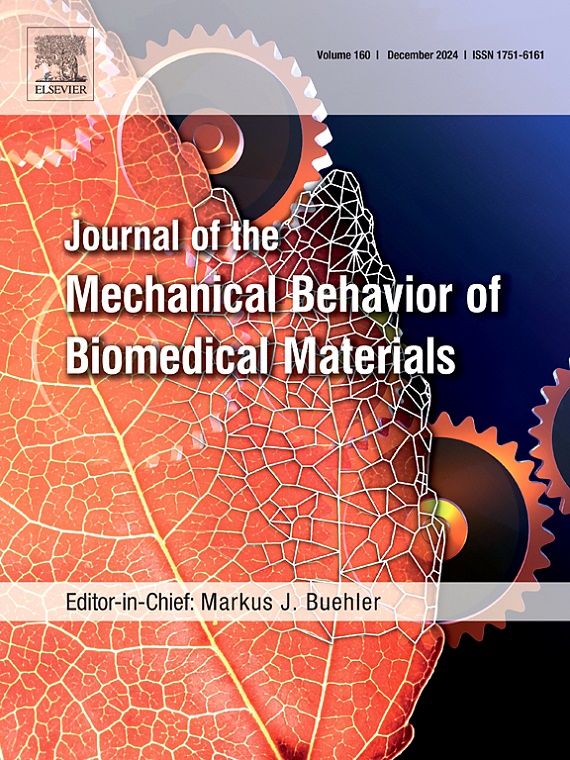Double 4-bar shear: A novel apparatus and method for simple shear mechanical analysis of membranes
IF 3.5
2区 医学
Q2 ENGINEERING, BIOMEDICAL
Journal of the Mechanical Behavior of Biomedical Materials
Pub Date : 2025-07-24
DOI:10.1016/j.jmbbm.2025.107113
引用次数: 0
Abstract
A new constitutive modeling strategy based on QR decomposition has been introduced for analyzing biological membranes, which uniquely separates 2D deformation into three physically meaningful modes: dilation, extrusion, and simple shear. While dilation and extrusion can be measured with standard biaxial testing, experimentally isolating and measuring simple shear has remained a significant challenge, with most methods failing to capture all boundary conditions.
To address this gap, a novel ”double 4-bar shear” apparatus was developed to apply a precise, rectilinear simple shear deformation while measuring all boundary loads and moments. The device was validated using 16 silicone membranes and 8 rat dorsal skin samples. Digital Image Correlation (DIC) analysis confirmed the apparatus successfully applies a homogeneous simple shear strain, as evidenced by the narrow distribution of strain components, and isolates it from other deformation modes.
For the first time, the moments applied by the material on the clamps during simple shear were successfully measured, showing a clear increase with rising shear strain. The results demonstrated highly repeatable and linear stress–strain behavior for silicone and a characteristic non-linear, J-curve response for rat skin. By providing a method to obtain previously unavailable experimental data, this apparatus enables the complete characterization of membranes using advanced constitutive models, which can significantly advance the design of tissue-engineered replacements with more accurate physiological properties.
双4杆剪切:一种新的膜的简单剪切力学分析仪器和方法
一种新的基于QR分解的生物膜本构建模策略,将二维变形独特地划分为三种有物理意义的模式:膨胀、挤压和简单剪切。虽然可以用标准的双轴测试来测量膨胀和挤压,但通过实验分离和测量简单的剪切仍然是一个重大挑战,大多数方法都不能捕获所有的边界条件。为了解决这一差距,开发了一种新型的“双4杆剪切”装置,用于在测量所有边界载荷和力矩的同时应用精确的直线简单剪切变形。该装置使用16个硅胶膜和8个大鼠背部皮肤样本进行验证。数字图像相关(DIC)分析证实,该装置成功地应用了均匀的简单剪切应变,证明了应变分量的狭窄分布,并将其与其他变形模式隔离开来。首次成功地测量了单剪切过程中材料对夹钳施加的力矩,随着剪切应变的增加,力矩明显增加。结果表明,硅酮具有高度可重复性和线性的应力应变行为,而大鼠皮肤具有非线性的j曲线响应。通过提供一种获得以前无法获得的实验数据的方法,该装置可以使用先进的本构模型对膜进行完整的表征,这可以显著推进具有更准确生理特性的组织工程替代品的设计。
本文章由计算机程序翻译,如有差异,请以英文原文为准。
求助全文
约1分钟内获得全文
求助全文
来源期刊

Journal of the Mechanical Behavior of Biomedical Materials
工程技术-材料科学:生物材料
CiteScore
7.20
自引率
7.70%
发文量
505
审稿时长
46 days
期刊介绍:
The Journal of the Mechanical Behavior of Biomedical Materials is concerned with the mechanical deformation, damage and failure under applied forces, of biological material (at the tissue, cellular and molecular levels) and of biomaterials, i.e. those materials which are designed to mimic or replace biological materials.
The primary focus of the journal is the synthesis of materials science, biology, and medical and dental science. Reports of fundamental scientific investigations are welcome, as are articles concerned with the practical application of materials in medical devices. Both experimental and theoretical work is of interest; theoretical papers will normally include comparison of predictions with experimental data, though we recognize that this may not always be appropriate. The journal also publishes technical notes concerned with emerging experimental or theoretical techniques, letters to the editor and, by invitation, review articles and papers describing existing techniques for the benefit of an interdisciplinary readership.
 求助内容:
求助内容: 应助结果提醒方式:
应助结果提醒方式:


